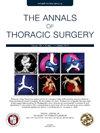脂质体布比卡因对肺切除手术后恢复的影响
IF 3.6
2区 医学
Q1 CARDIAC & CARDIOVASCULAR SYSTEMS
引用次数: 0
摘要
背景:有限的数据显示,作为术后强化恢复(ERAS)方案的一部分,脂质体布比卡因可减少微创肺叶切除术中阿片类药物的使用:一项回顾性观察研究比较了2015年1月至2021年12月期间接受肺叶切除术的三组患者。对照组既没有在术中接受脂质体布比卡因,也没有接受ERAS方案。脂质体布比卡因组仅接受了神经阻滞,而ERAS组在术中接受了神经阻滞,并接受了ERAS方案。主要结果是术后阿片类药物的消耗量:本研究共有433名患者(对照组87人,单用脂质体布比卡因组138人,ERAS/脂质体布比卡因组208人)。对照组(43 OME)和单独使用脂质体布比卡因组(30.5 OME)的阿片类药物用量差异有统计学意义(p结论:单独使用脂质体布比卡因作为ERAS大方案的一部分,可显著减少阿片类药物的使用量和住院时间;然而,将脂质体布比卡因纳入ERAS方案中,阿片类药物使用量的减少幅度要比单独使用大得多。需要进行前瞻性研究,以确定脂质体布比卡因在其他美国医院系统中减少阿片类药物使用的可重复性和适用性。本文章由计算机程序翻译,如有差异,请以英文原文为准。
Impact of Liposomal Bupivacaine on Enhanced Recovery After Surgery Protocol for Lung Resection
Background
There is limited data showing the benefit of liposomal bupivacaine as part of an Enhanced Recovery After Surgery (ERAS) protocol in reducing opioid use in minimally invasive lobectomies.
Methods
A retrospective observational study compared 3 cohorts of patients who underwent lobectomies between January 2015 and December 2021. The control group neither received liposomal bupivacaine intraoperatively nor underwent an ERAS protocol. The liposomal bupivacaine cohort only received a nerve block, whereas the ERAS cohort received a nerve block intraoperatively and underwent an ERAS protocol. The primary outcome was postoperative opioid consumption.
Results
The study included 433 patients, comprising 87 in the control group, 138 in the liposomal bupivacaine alone cohort, and 208 in the ERAS/liposomal bupivacaine cohort. There was a statistically significant difference in the amount of opioids used between the control (43 oral morphine equivalents [OME]) and liposomal bupivacaine alone cohort (30.5 OME; P < .001), between control vs the ERAS/liposomal bupivacaine cohort (17 OME; P < .001), and between the liposomal bupivacaine alone and ERAS/liposomal bupivacaine cohorts (P < .001). Hospital stay was not statistically different between the 2 groups of interest (3 days); however, hospital stay differed from the control (4 days). Readmission at 30 days was not significantly different between the 3 groups (P = .43).
Conclusions
Liposomal bupivacaine alone as part of a larger ERAS protocol significantly reduced opioid use and hospitalization duration; however, the reduction in opioid use was much greater with incorporation of liposomal bupivacaine into an ERAS protocol rather than in isolation. Prospective studies are needed to determine reproducibility and applicability of liposomal bupivacaine for opioid use reduction in other United States hospital systems.
求助全文
通过发布文献求助,成功后即可免费获取论文全文。
去求助
来源期刊

Annals of Thoracic Surgery
医学-呼吸系统
CiteScore
6.40
自引率
13.00%
发文量
1235
审稿时长
42 days
期刊介绍:
The mission of The Annals of Thoracic Surgery is to promote scholarship in cardiothoracic surgery patient care, clinical practice, research, education, and policy. As the official journal of two of the largest American associations in its specialty, this leading monthly enjoys outstanding editorial leadership and maintains rigorous selection standards.
The Annals of Thoracic Surgery features:
• Full-length original articles on clinical advances, current surgical methods, and controversial topics and techniques
• New Technology articles
• Case reports
• "How-to-do-it" features
• Reviews of current literature
• Supplements on symposia
• Commentary pieces and correspondence
• CME
• Online-only case reports, "how-to-do-its", and images in cardiothoracic surgery.
An authoritative, clinically oriented, comprehensive resource, The Annals of Thoracic Surgery is committed to providing a place for all thoracic surgeons to relate experiences which will help improve patient care.
 求助内容:
求助内容: 应助结果提醒方式:
应助结果提醒方式:


